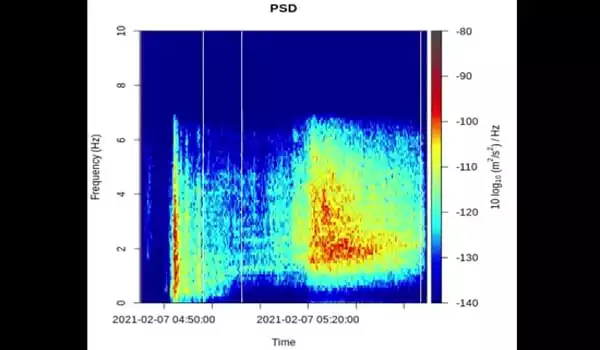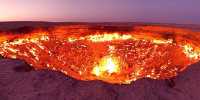The scientific account of the devastating rockslide in India’s Dhauli Ganga Valley reads like a forensic report. A rockslide and ensuing flood killed at least 100 people and destroyed two hydroelectric power plants. Researchers from the GFZ German Research Center for Geosciences (GFZ) and colleagues from the National Geophysical Research Institute of India (NGRI) trace the disaster minute by minute using data from a network of seismometers in the scientific journal Science. Seismic networks, according to the team, could be used to establish an early warning system for high mountain regions.
Although the ultimate cause of the massive rockslide that began at an elevation of more than 5500 meters is unknown, one thing is certain: On Sunday, February 7, 2021, just before half past ten a.m., more than 20 million cubic meters of ice and rock began to flow downslope into the Ronti Gad River valley. The signal was recorded by seismometers at 10:21 a.m. and 14 seconds local time. The mass collided with the valley floor at 3730 meters elevation 54 seconds later, causing an impact equivalent to a magnitude 3.8 earthquake.
The combination of rock and ice in the valley mobilized debris and additional ice, which, when mixed with water, rolled through the valleys of the Ronti Gad and Rishi Ganga rivers as a massive debris flow and flood. First author Kristen Cook of GFZ estimates that the mass initially moved at nearly 100 kilometers per hour before slowing to just under 40 kilometers per hour after about ten minutes.
The flood reached a major road bridge near Joshimath at 10:58 and 33 seconds. The water level there rose by 16 meters in a matter of seconds. Thirty kilometers down the valley, the Chinka gauge station recorded a 3.6-meter rise in water level, and sixty kilometers further down, the level rose by 1 meter.
Researchers traced the disaster minute by minute using data from a network of seismometers. The team posits that seismic networks could be used to establish an early warning system for high mountain regions.
The collective research of partners from the GFZ’s sections Geomorphology, Seismic Hazard and Risk Dynamics, and Physics of Earthquakes and Volcanoes, as well as NGRI colleagues, identified three distinct phases of the catastrophic flood based on the ground-shaking signals recorded by the seismic stations. The first phase involved the rockslide and its massive impact on the valley floor. Phase 2 began with the mobilization of massive amounts of material — ice, debris, and mud — resulting in a devastating wall of material rushing through a narrow winding valley, where much of the material remained and the energy rapidly decreased with time. This lasted approximately thirteen minutes. Phase 3 (fifty minutes in duration) was more flood-like, with massive amounts of water that flowed downstream, carrying along large boulders up to 20 m across.

“The data from seismic instruments are suitable as a basis for an early warning system that warns of the arrival of such catastrophic debris flows,” says Niels Hovius, the study’s final author and acting scientific director of the GFZ German Research Center for Geosciences. Another critical point is the presence of a dense seismic network, which is managed by Indian colleagues at the Indian National Geophysical Research Institute (NGRI).
The first author of the paper, Hovius’ colleague Kristen Cook, adds, “the available warning time for sites located in valleys depends on the downstream distance and speed of the flow front.” Joshimath, for example, where the river level rose 16 meters during the flood, was 34.6 kilometers downstream from the landslide. “That means people in and around Joshimath could have received a warning about half an hour before the flood arrived,” says Kristen Cook. Where the wave arrived just a few minutes after the landslide, it may have been enough to shut down power plants further upstream.
So, why hasn’t a warning system like this been in place for a long time? Fabrice Cotton, Section Head of Seismic Hazard and Risk Dynamics, states: “The issue is that different seismic measuring station requirements make many stations in our global and regional earthquake networks less suitable for detecting rockfalls, debris flows, or major floods. Simultaneously, stations designed to monitor floods and debris flows in their immediate vicinity are less effective at detecting events at a distance.”
The solution developed by the GFZ researchers in collaboration with their colleagues in India and Nepal is a compromise: Stations would be established at strategic locations to serve as the backbone of a high-mountain flood early warning system. Marco Pilz claims that “In some ways, this trade-off is an optimization problem that future studies will have to address, and where we have already made systematic progress, such as in the German Lower Rhein Bay region. Further investigation of flash floods and debris flows will aid in understanding of how seismic signals can aid in early warning.”
The first ideas for establishing such an early-warning system based on a seismological approach emerged in the spring of 2019 as a result of a joint workshop of Helmholtz researchers and Indian colleagues in Bangalore. The current study project was initiated by NGRI’s Virendra Tiwari and Niels Hovius. It made use of a flood and a regional seismic network already established by the Indian National Geophysical Research Institute.
According to Hovius: “Early warning is becoming increasingly important as mountain rivers are increasingly used to generate hydropower, which is seen as a driver of economic development in some of the world’s poorest mountain regions. Given that catastrophic floods are likely to become more common as the climate warms, causing rapid glacier retreat and precarious ponding of melt water in high places, future risks will increase even more.”














